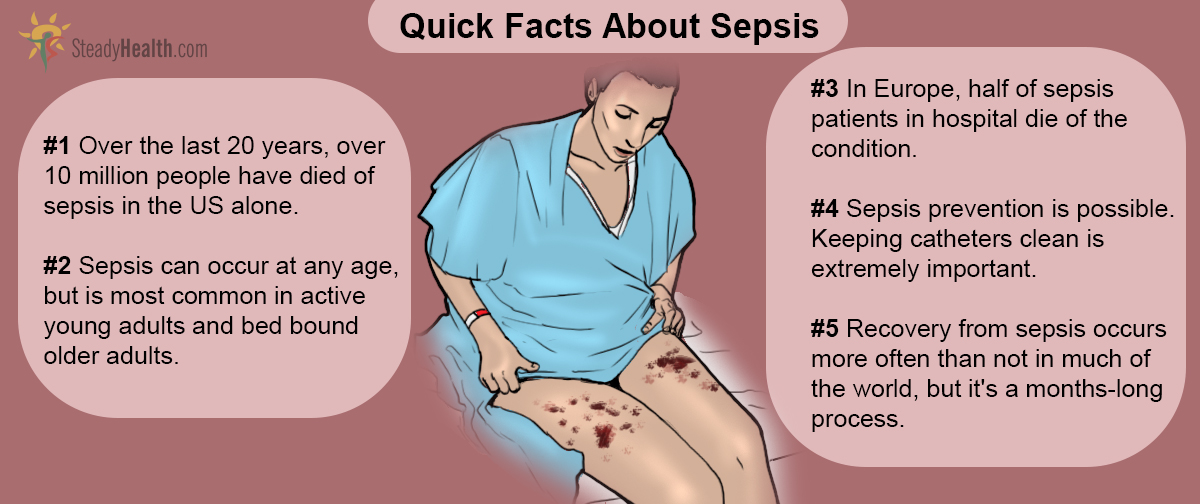Table of Contents
In the English language, the ill-defined terms sepsis, septicemia, and septic shock refer to a a condition of systemic inflammation that can cause whole organ systems to shut down.
For this article, we'll refer to all three conditions as "sepsis," which can refer to septicemia, a body-wide bacterial infection, systemic inflammatory response, a body-wide condition of inflammation, or both events occurring at the same time. Sepsis usually involves bacteria, but it can involve viruses, parasites, or fungi, and systemic inflammatory response can include pancreatitis, burns, and trauma.
What you need to know to survive these conditions is the same regardless of the cause.

The Symptoms Of Sepsis Are Insidious And Vague
The initial symptoms of sepsis are hard to diagnose because they are so non-specific.
The most common symptom of sepsis in older people is not something you will usually read about online in articles about sepsis. It's confusion. Someone in the early stages of sepsis may suddenly start acting as if she or he had Alzheimer's. Then there can be anxiety. Someone who has sepsis may not want to go to see the doctor or go to the emergency room, whether because the person is anxious or not taking the problem seriously.
Then as the problem progresses, there is no particular order in which organ systems will begin to run amok. There can be:
- Neurological symptoms. These can include a stiff neck, ear ache, sore throat, and "the worst headache ever," in addition to an altered mental status.
- Respiratory symptoms. Sepsis is more likely to cause a productive, "phlegmy" cough than a dry cough. There can be shortness of breath and difficulty breathing.
- Gastrointestinal symptoms. Diarrhea is not unusual in cases of sepsis. Neither is abdominal tenderness. Swelling can occur where it is not expected, in places such as the rectum.
- Bone and muscle symptoms. There can be joint pain, swollen muscles, and stiffness.
- Urogenital symptoms. Urination may be scanty of difficult, and the patient's urine may be dark. There can be flank (kidney) pain.
- Skin symptoms. The skin can appear bruised, either with tiny petecchiae or with larger blue and purple spots. It can blister.
The problem with getting a good diagnosis of sepsis is that any, all, or some of these symptoms can occur in any order — as well as that all of these symptoms can be caused by different medical problems. Sometimes all a patient will have to go on is the certain knowledge that "something is very wrong" and the only thing to do is to report to an emergency room.
READ The Five Signs Of Wound Infection
Sepsis Leads To Shock
Once sepsis has set in, multiple organ systems begin to malfunction, resulting in shock. Basically, shock is the body's loss of the ability to maintain circulation. The heart may work very hard but be unable to circulate blood because blood vessels are dilated. The kidneys may not get enough circulation to keep producing urine.
The skin may be pale, cool, and clammy, and the heart may beat fast (more than 90 beats per minute), breathing may be shallow but rapid (more than 20 breaths per minute), and the patient's body temperature may fluctuate, higher than 38°C (100.4°F) or lower than 36°C (96.8°F). All of these symptoms seem to result from an over-response of the immune system either to an infection, or to tissue injury and blood loss.
- Brun-Buisson C, Doyon F, Carlet J, et al. Incidence, risk factors, and outcome of severe sepsis and septic shock in adults. A multicenter prospective study in intensive care units. French ICU Group for Severe Sepsis. JAMA. Sep 27 1995. 274(12):968-74.
- Dellinger RP, Levy MM, Rhodes A, Annane D, Gerlach H, Opal SM, et al. Surviving sepsis campaign: international guidelines for management of severe sepsis and septic shock: 2012. Crit Care Med. Feb 2013.41(2):580-637.
- Mind map by SteadyHealth.com
- Mind map by SteadyHealth.com
- Photo courtesy of jcampbell104 via Flickr: www.flickr.com/photos/104346167@N06/16916332265


Your thoughts on this